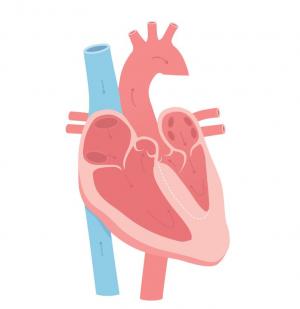Hypertrophic cardiomyopathy (HCM) is a slowly debilitating condition where the heart muscle thickens inappropriately. The disease is inherited and it is estimated it may affect as many as one in 500 people.
The faulty gene can be inherited from either parent, and relatives may have similar heart problems and symptoms. Even in the absence of symptoms, affected people may have a risk of complications and need to be screen preventatively.
Initial symptoms such as excessive tiredness can be so unspecific and easily ascribed to our modern lifestyle, that the condition isn’t suspected (unless a relative in the family was previously identified as having the disease) until much later on when it has progressed to create an obstruction inside the heart itself. At that point, the condition is referred to as hypertrophic obstructive cardiomyopathy (HOCM).

We recently operated on Mr G, a man who was diagnosed with HOCM a few years ago.
Since the heart muscle thickens at a very slow pace, symptoms creep in over a long period of time. Mr G initially misinterpreted his increasingly limited exercise ability and stamina as simply getting older and he didn’t think he needed a doctor’s examination.
Eventually, a cardiologist made the diagnosis of HCM. He was advised to seek a subspecialty opinion and he initially looked within his home country. He was told he needed surgery and that it was a very complex procedure with risks.
Understandably, he was concerned and didn’t want to rush into a big heart operation. He knew he would have to seek out the few clinicians able to lend world-leading expertise in this field.
After reading about the work of Dr Antonis Pantazis, chief cardiologist in inherited cardiac conditions (ICD) at Royal Brompton & Harefield Hospitals Specialist Care, Mr G travelled to London to seek treatment. He had developed a high degree of obstruction due to the interaction between the thickened heart muscle and one of the valves inside the heart called the mitral valve. Any obstruction in the outflow of blood can also be harmful to the heart in the long term. Due to the obstruction, the pressures inside the heart increase and the walls of the top chamber of the heart, the atrium, are stretched.
The patient’s heart had to struggle against a blockage and the amount of blood that could move forward was severely reduced. The mitral valve was also leaking severely as a result of the abnormal blood flow.
Dr Pantazis adjusted his medication, which provided immediate improvement in his symptoms and quality of life. For several months all seemed to return to normal and he regained his energy and stamina.
When he experienced side effects from the medication and his symptoms reappeared, he began to consider a more definitive treatment.
Two types of invasive options
These two options are alcohol septal ablation and surgical septal myectomy. The type of intervention has to be decided based on anatomy, function, concomitant diseases and patient preference.
Mr G was referred to Mr Fabio De Robertis, consultant cardiac and transplant surgeon at Royal Brompton & Harefield Specialist Care for a surgical procedure called septal myectomy.
Mr De Robertis recalls: “When I met this patient I was struck by how resilient he had been over the years, putting up with his symptoms whilst continuing with a busy lifestyle. He had now come to the conclusion he needed surgery but he wasn’t particularly happy about it.”
“His anatomy was typical of HOCM patients, and could be addressed by septal myectomy [a surgical thinning of the excessive heart muscle], in combination with a specific technique of mitral repair that preserves the valve and addresses only the abnormalities of the structures supporting it, namely the papillary muscles and the chords.”
He was reassured there was no need for valve replacement, a fact that put Mr G’s mind at rest as he no longer had to consider the implications of life-long anticoagulation drugs in the case of a mechanical valve prosthesis or possible re-operation in 10 to 15 years in the case of implantation of a tissue valve.
Admission
He was admitted to Harefield Hospital, the operation was completed by the afternoon and Mr G woke up from anaesthetic in the Harefield recovery unit by early evening.
The following day he was out of bed having breakfast and was then moved to the high dependency unit. From there he went on to mobilise and recover very well. He achieved the planned target with ease and could be discharged from the hospital five days after the surgery.
His surgeon and cardiologist followed him very closely after the operation. Three weeks later his progress was assessed again in the outpatient clinic by Mr De Robertis and Dr Pantazis. Everything had gone according to plan and Mr G was able to take a flight back to his home country. Since the surgery, he has gone back to a normal life without his limiting symptoms.
It is important to note that every patient with HCM and LVOTO is different. This applies to the preoperative, intraoperative and postoperative period.
Mr De Robertis has a special interest in the surgical septal myectomy and is able to deliver a broad spectrum of surgical options for the correction of the multiple and occasionally unexpected variations of abnormalities in Hypertrophic cardiomyopathy. His experience has been enriched through his contacts with centres of excellence in this field in Europe and in the US.
At a glance
Procedure
Septal myectomy
Carried out by
Mr Fabio De Robertis and Dr Antonis Pantazis
What problems does it solve?
The length of the incision is smaller than in a traditional lobectomy.
How does it work?
Treatment for hypertrophic cardiomyopathy. The open-heart surgery entails removing a portion of the septum that is obstructing the flow of blood from the left ventricle to the aorta.
Contact us
For more information or to book an appointment, please contact our customer care team.

